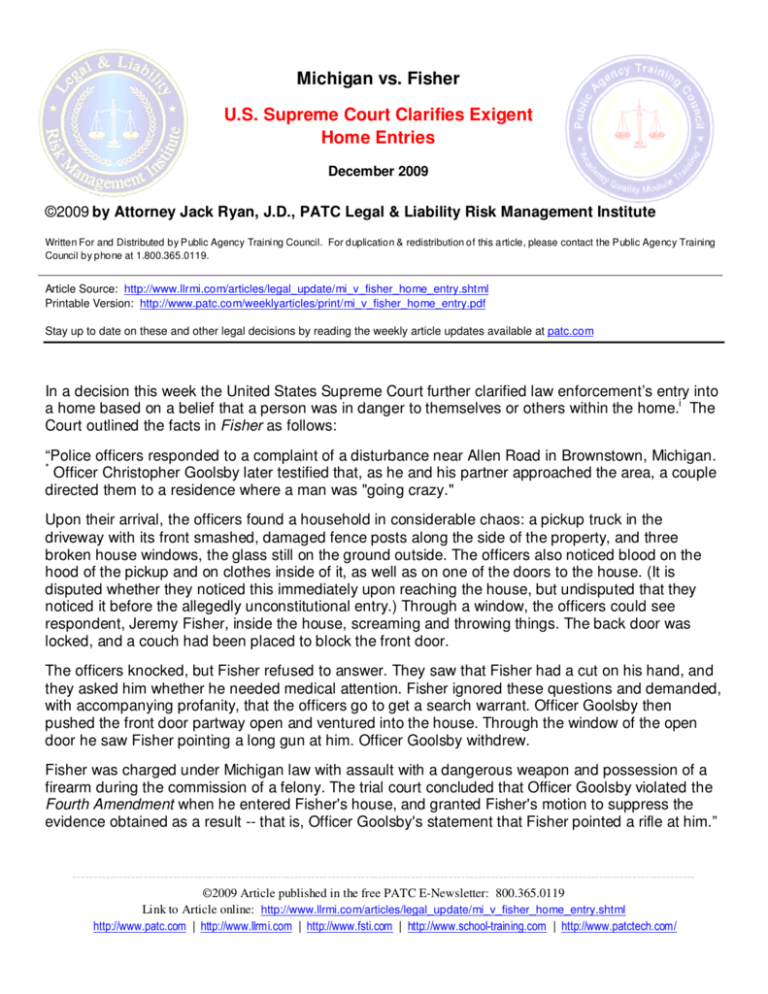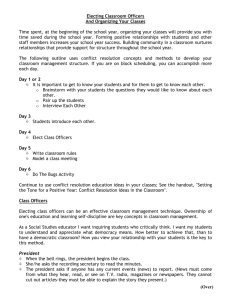Michigan vs. Fisher - US Supreme Court Clarifies Exigent Home
advertisement

Michigan vs. Fisher U.S. Supreme Court Clarifies Exigent Home Entries December 2009 ©2009 by Attorney Jack Ryan, J.D., PATC Legal & Liability Risk Management Institute Written For and Distributed by Public Agency Training Council. For duplication & redistribution of this article, please contact the Public Agency Training Council by phone at 1.800.365.0119. Article Source: http://www.llrmi.com/articles/legal_update/mi_v_fisher_home_entry.shtml Printable Version: http://www.patc.com/weeklyarticles/print/mi_v_fisher_home_entry.pdf Stay up to date on these and other legal decisions by reading the weekly article updates available at patc.com In a decision this week the United States Supreme Court further clarified law enforcement’s entry into a home based on a belief that a person was in danger to themselves or others within the home.i The Court outlined the facts in Fisher as follows: “Police officers responded to a complaint of a disturbance near Allen Road in Brownstown, Michigan. Officer Christopher Goolsby later testified that, as he and his partner approached the area, a couple directed them to a residence where a man was "going crazy." * Upon their arrival, the officers found a household in considerable chaos: a pickup truck in the driveway with its front smashed, damaged fence posts along the side of the property, and three broken house windows, the glass still on the ground outside. The officers also noticed blood on the hood of the pickup and on clothes inside of it, as well as on one of the doors to the house. (It is disputed whether they noticed this immediately upon reaching the house, but undisputed that they noticed it before the allegedly unconstitutional entry.) Through a window, the officers could see respondent, Jeremy Fisher, inside the house, screaming and throwing things. The back door was locked, and a couch had been placed to block the front door. The officers knocked, but Fisher refused to answer. They saw that Fisher had a cut on his hand, and they asked him whether he needed medical attention. Fisher ignored these questions and demanded, with accompanying profanity, that the officers go to get a search warrant. Officer Goolsby then pushed the front door partway open and ventured into the house. Through the window of the open door he saw Fisher pointing a long gun at him. Officer Goolsby withdrew. Fisher was charged under Michigan law with assault with a dangerous weapon and possession of a firearm during the commission of a felony. The trial court concluded that Officer Goolsby violated the Fourth Amendment when he entered Fisher's house, and granted Fisher's motion to suppress the evidence obtained as a result -- that is, Officer Goolsby's statement that Fisher pointed a rifle at him.” ----------------------------------------------------------------------------------------------------------------------------------------------------©2009 Article published in the free PATC E-Newsletter: 800.365.0119 Link to Article online: http://www.llrmi.com/articles/legal_update/mi_v_fisher_home_entry.shtml http://www.patc.com | http://www.llrmi.com | http://www.fsti.com | http://www.school-training.com | http://www.patctech.com/ In its review of the case the Court noted its previous decision in Brigham City v. Stuart. Brigham City v. Stuart,ii involved a fairly typical police event. Officers from Brigham City were called at 3:00 a.m. about a loud party at a residence. Two officers approached the house and heard yelling and what sounded like a disturbance at the rear of the house. The officers documented the fact that they heard “thumping and crashing” and someone yelling “stop, stop…get off me.” The officers could not see anything from the front door so they did not knock. Instead, they walked to the rear of the house, where they initially observed two juveniles drinking beer. The officers walked to the rear door and could see into the kitchen. Prior to knocking or entering the officers could see four adults attempting to restrain a juvenile. As the officers watched, the juvenile broke free and punched one of the adults in the face. The adult who was punched walked to the kitchen sink and spit blood into the sink. Having observed the fracas in the kitchen, one of the officers opened the screen door and announced the police presence. Due the continued fracas, no one paid attention. The officers then stepped into the kitchen and again announced their presence. This second announcement caused the disturbance to subside and order was restored. While inside the house, the officers observed evidence in plain view leading to probable cause that the adults who were present had provided alcoholic beverages to the juveniles at the party. The evidence was seized and the adults were charged with contributing to the delinquency of minors. The adults challenged the seizure of the evidence from the house arguing that the police should have obtained a warrant before entering. The first element of a “plain view” seizure is that police must be lawfully present in an area protected by the Fourth Amendment. There is no question that the residence was protected by the Fourth Amendment. The question in this case is whether the officers were lawfully present inside the residence. There are three ways in which law enforcement can gain lawful presence inside a home. The first is with a warrant; the second is with consent; and, the third is under exigent circumstances. The police in this case were relying on exigent circumstances to justify the entry in this case. It should be noted that some courts distinguish exigent circumstances from an “emergency aid” exception. The distinction between the two is of little importance with respect to a practical application by officers since both of these exceptions indicate that there is no time for police to obtain a warrant due to some ongoing emergency circumstance. In its review of the case, the United States Supreme Court held that police may enter a home when faced with facts supporting that there is ongoing violence occurring inside. “In these circumstances, the officers had an objectively reasonable basis for believing both that the injured adult might need help and that the violence in the kitchen was just beginning. Nothing in the Fourth Amendment required them to wait until another blow rendered someone “unconscious” or “semi-conscious” or worse before entering. The role of a peace officer includes preventing violence and restoring order, not simply rendering first aid to casualties; an officer is not like a boxing (or hockey) referee, poised to stop a bout only if it becomes too one-sided.” Having concluded that the entry was reasonable the court then examined the method of the entry and concluded: “The manner of the officers’ entry was also reasonable. After witnessing the punch, one of the officers opened the screen door and ‘yelled in police.’ When nobody heard him, he stepped into the kitchen and announced himself again. Only then did the tumult subside. The officer’s announcement of his presence was at least equivalent to a knock on the screen door. Indeed, it was probably the only option that had even a chance of rising above the din. Under these circumstances, there was no violation of the Fourth Amendment’s knock-and-announce rule. ----------------------------------------------------------------------------------------------------------------------------------------------------©2009 Article published in the free PATC E-Newsletter: 800.365.0119 Link to Article online: http://www.llrmi.com/articles/legal_update/mi_v_fisher_home_entry.shtml http://www.patc.com | http://www.llrmi.com | http://www.fsti.com | http://www.school-training.com | http://www.patctech.com/ Having concluded that the decision to enter was objectively reasonable and that the manner of entry was reasonable under the Fourth Amendment, the Court held that the evidence should not have been suppressed and should be allowed in the prosecution of these adults. In applying Brigham to the Fisher case, the Court concluded that the entry in Fisher, based upon the observations of the officers was objectively reasonable. The Court asserted: “A straightforward application of the emergency aid exception, as in Brigham City, dictates that the officer's entry was reasonable. Just as in Brigham City, the police officers here were responding to a report of a disturbance. Just as in Brigham City, when they arrived on the scene they encountered a tumultuous situation in the house -- and here they also found signs of a recent injury, perhaps from a car accident, outside. And just as in Brigham City, the officers could see violent behavior inside. Although Officer Goolsby and his partner did not see punches thrown, as did the officers in Brigham City, they did see Fisher screaming and throwing things. It would be objectively reasonable to believe that Fisher's projectiles might have a human target (perhaps a spouse or a child), or that Fisher would hurt himself in the course of his rage. In short, we find it as plain here as we did in Brigham City that the officer's entry was reasonable under the Fourth Amendment.” The Court noted that the Michigan court had concluded that mere drops of blood were insufficient to establish a belief of serious injury within the house. The Court returned to Brigham City in rejecting this lower court opinion: “Even a casual review of Brigham City reveals the flaw in this reasoning. Officers do not need ironclad proof of ‘a likely serious, life-threatening’ ’injury to invoke the emergency aid exception. The only injury police could confirm in Brigham City was the bloody lip they saw the juvenile inflict upon the adult. Fisher argues that the officers here could not have been motivated by a perceived need to provide medical assistance, since they never summoned emergency medical personnel. This would have no bearing, of course, upon their need to assure that Fisher was not endangering someone else in the house. Moreover, even if the failure to summon medical personnel conclusively established that Goolsby did not subjectively believe, when he entered the house, that Fisher or someone else was seriously injured (which is doubtful), the test, as we have said, is not what Goolsby believed, but whether there was ‘an objectively reasonable basis for believing’ that medical assistance was needed, or persons were in danger.” The Court concluded: “It does not meet the needs of law enforcement or the demands of public safety to require officers to walk away from a situation like the one they encountered here. Only when an apparent threat has become an actual harm can officers rule out innocuous explanations for ominous circumstances. But ‘[t]he role of a peace officer includes preventing violence and restoring order, not simply rendering first aid to casualties.’ It sufficed to invoke the emergency aid exception that it was reasonable to believe that Fisher had hurt himself (albeit non-fatally) and needed treatment that in his rage he was unable to provide, or that Fisher was about to hurt, or had already hurt, someone else. The Michigan Court of Appeals required more than what the Fourth Amendment demands.” ----------------------------------------------------------------------------------------------------------------------------------------------------©2009 Article published in the free PATC E-Newsletter: 800.365.0119 Link to Article online: http://www.llrmi.com/articles/legal_update/mi_v_fisher_home_entry.shtml http://www.patc.com | http://www.llrmi.com | http://www.fsti.com | http://www.school-training.com | http://www.patctech.com/ Key Point: Where an officer’s personal observations or reliable information would lead a reasonable officer to conclude that ongoing violence is occurring in a residence, officers may enter without a warrant under the exigency exception to the warrant requirement. Key Point: Officers who are faced with an on-going violent situation in a home need not wait until serious injury results before making an entry. Key Point: Officers are given broader deference for exigency under the “emergency aid exception” as opposed to other types of exigency such as destruction of evidence. i ii Michigan v. Fisher, ___U.S.___ ; 2009 USLEXIS 8773 (2009). Brigham City v. Stuart, ___U.S.___ , 126 S.Ct. 1943 (2006). ----------------------------------------------------------------------------------------------------------------------------------------------------©2009 Article published in the free PATC E-Newsletter: 800.365.0119 Link to Article online: http://www.llrmi.com/articles/legal_update/mi_v_fisher_home_entry.shtml http://www.patc.com | http://www.llrmi.com | http://www.fsti.com | http://www.school-training.com | http://www.patctech.com/







